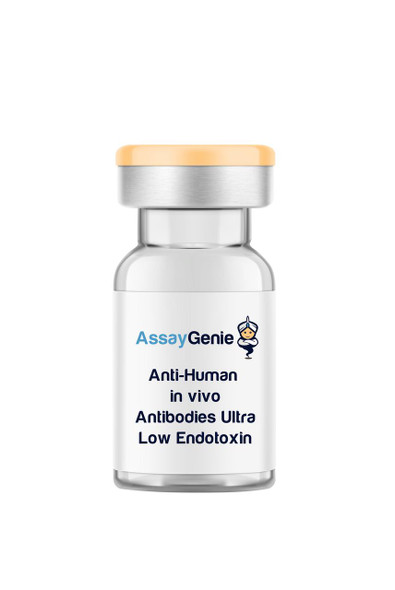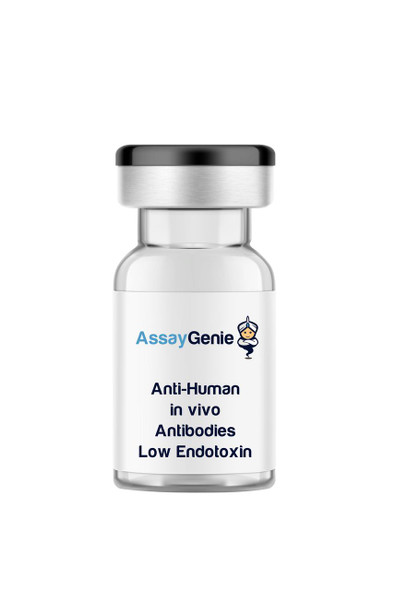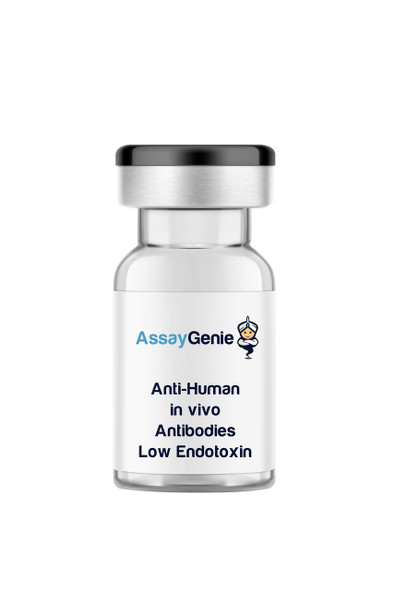Anti-Human CD166 (ALCAM) In Vivo Antibody - Low Endotoxin
- SKU:
- IVMB0248
- Product Type:
- In Vivo Monoclonal Antibody
- Clone:
- 3A6
- Protein:
- CD166
- Isotype:
- IgG1 k
- Reactivity:
- Human
- Synonyms:
- CD6 ligand
- Synonyms:
- Activated Leukocyte Cell Adhesion Molecule (ALCAM)
- Research Area:
- Cell Adhesion
- Research Area:
- Cell Biology
- Research Area:
- Immunology
- Research Area:
- Neuroscience
- Research Area:
- Synaptic Biology
- Endotoxin Level:
- Low Endotoxin
- Host Species:
- Mouse
- Applications:
- FC
- Applications:
- IF
- Applications:
- IF Microscopy
- Applications:
- IHC
- Applications:
- In Vivo
- Applications:
- IP
Description
| Product Name: | Anti-Human CD166 (ALCAM) In Vivo Antibody - Low Endotoxin |
| Product Code: | IVMB0248 |
| Size: | 1 mg, 5 mg, 25 mg, 50 mg, 100 mg |
| Clone: | 3A6 |
| Product Type: | Monoclonal Antibody |
| Synonyms: | CD6 ligand, Activated Leukocyte Cell Adhesion Molecule (ALCAM) |
| Isotype: | IgG1 k |
| Reactivity: | Human |
| Applications: | FC, IF, IF Microscopy, IHC, In Vivo, IP |
| Formulation: | This monoclonal antibody is aseptically packaged and formulated in 0.01 M phosphate buffered saline (150 mM NaCl) PBS pH 7.2 - 7.4 with no carrier protein, potassium, calcium or preservatives added. Due to inherent biochemical properties of antibodies, certain products may be prone to precipitation over time. Precipitation may be removed by aseptic centrifugation and/or filtration. |
| Endotoxin Level: | < 1.0 EU/mg as determined by the LAL method |
| Purity: | ≥95% monomer by analytical SEC ⋅ >95% by SDS Page |
| Product Preparation: | Functional grade preclinical antibodies are manufactured in an animal free facility using in vitro cell culture techniques and are purified by a multi-step process including the use of protein A or G to assure extremely low levels of endotoxins, leachable protein A or aggregates. |
| Applications: | FC, IF, IF Microscopy, IHC, In Vivo, IP |
| Reactivity: | Human |
| Host Species: | Mouse |
| Specificity: | 3A6 activity is directed against human CD166 (ALCAM) and cross-reacts with ovine tissues. |
| Antigen Distribution: | CD166 is expressed on neurons, activated leukocytes, hematopoietic stem cells, mesenchymal stem cells, bone marrow stromal cells, activated T cells, activated B cells, activated monocytes, thymic epithelial cells, vascular endothelial cells, fibroblasts, keratinocytes, myeloid progenitors, tumor cells, and cancer stem cells. |
| Immunogen: | Cultured human thymic epithelial cells |
| Concentration: | ≥ 5.0 mg/ml |
| Endotoxin Level: | < 1.0 EU/mg as determined by the LAL method |
| Formulation: | This monoclonal antibody is aseptically packaged and formulated in 0.01 M phosphate buffered saline (150 mM NaCl) PBS pH 7.2 - 7.4 with no carrier protein, potassium, calcium or preservatives added. Due to inherent biochemical properties of antibodies, certain products may be prone to precipitation over time. Precipitation may be removed by aseptic centrifugation and/or filtration. |
| Purity: | ≥95% monomer by analytical SEC ⋅ >95% by SDS Page |
| Preparation: | Functional grade preclinical antibodies are manufactured in an animal free facility using in vitro cell culture techniques and are purified by a multi-step process including the use of protein A or G to assure extremely low levels of endotoxins, leachable protein A or aggregates. |
| Storage and Handling: | Functional grade preclinical antibodies may be stored sterile as received at 2-8°C for up to one month. For longer term storage, aseptically aliquot in working volumes without diluting and store at -70°C. Avoid Repeated Freeze Thaw Cycles. |
| Research Area: | Cell Adhesion, Cell Biology, Immunology, Neuroscience, Synaptic Biology |
| NCBI Gene Bank ID: | 214 |






